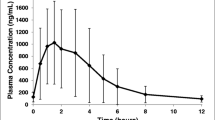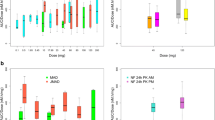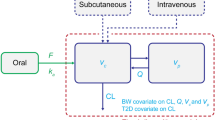Summary
Forty-four healthy male volunteers participated in an investigation of the pharmacokinetics and tolerance of single oral doses of romazarit, a potential disease-modifying antirheumatic drug. The study design involved single oral doses in ascending sequence from 40 to 1500 mg. At each dosage 9 volunteers were studied, of whom 6 received romazarit and 3 received placebo capsules in a double-blind manner. Tolerance was assessed before and after each of the 57 romazarit and 27 placebo doses. Plasma and urinary concentrations of romazarit were measured by HPLC with UV detection. Model-independent pharmacokinetic analyses showed that romazarit was rapidly and extensively absorbed in a dose-proportional manner. Urinary recovery of drug related material was about 70% of the dose and almost all in the form of labile metabolites (probably acyl glucuronides). Clearance was faster (>3 1/h) at doses below 700 mg, than in the range 700–1500 mg (1.7 1/h). It is suggested that two or more clearance mechanisms are present. One of these mechanisms is saturable and may involve a reversible ester glucuronide formation coupled with saturable tubular secretion of glucuronides. Romazarit was well tolerated in these healthy volunteers. There were two reports of stomach pain, one associated with vomiting. Changes in laboratory safety test results and in measurements of vital signs were similar in frequency and magnitude after romazarit and after placebo doses.
Similar content being viewed by others
References
Bloxham D.P., Bradshaw D., Cashin C.H., et al. (1990): Biological properties of romazarit (Ro 31-3948), a potential disease-modifying antirheumatic drug. J. Pharmacol. Exp. Ther., 252, 1331–1340.
Faed E.M. (1984): Properties of acyl glucuronides: implications for studies of the pharmacokinetics and metabolism of acidic drugs. Drug Metab. Rev., 15, 1213–1249.
Smith P.C., Langendijk P.N.J., Bosso J.A., Benet L.Z. (1985): Effect of probenecid on the formation and elimination of acyl glucuronides: studies with zomepirac. Clin. Pharmacol. Ther., 38, 121–127.
Verbeeck R.K., Wallace S.M., Loewen G.R. (1984): Reduced elimination of ketoprofen in the elderly is not necessarily duc to impaired glucuronidation. Br. J. Clin. Pharmacol., 17, 783–784.
Meffin P.J., Zilm D.M., Veenendaal J.R. (1983): Reduced clofibric acid clearance in renal dysfunction is due to a futile cycle. J. Pharmacol. Exp. Ther., 22, 732–783.
Bird, et al. (1989): Abstract to ILAR, Rio de Janeiro, Brazil.
Author information
Authors and Affiliations
Rights and permissions
About this article
Cite this article
Williams, P.E.O., Muirhead, G.J., Worth, E. et al. Pharmacokinetics and tolerance of romazarit after oral administration of ascending single doses to healthy human volunteers. Eur. J. Drug Metab. Pharmacokinet. 15, 317–322 (1990). https://doi.org/10.1007/BF03190221
Received:
Issue Date:
DOI: https://doi.org/10.1007/BF03190221




